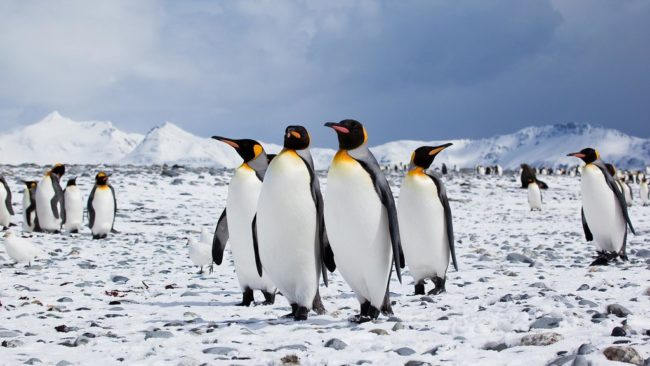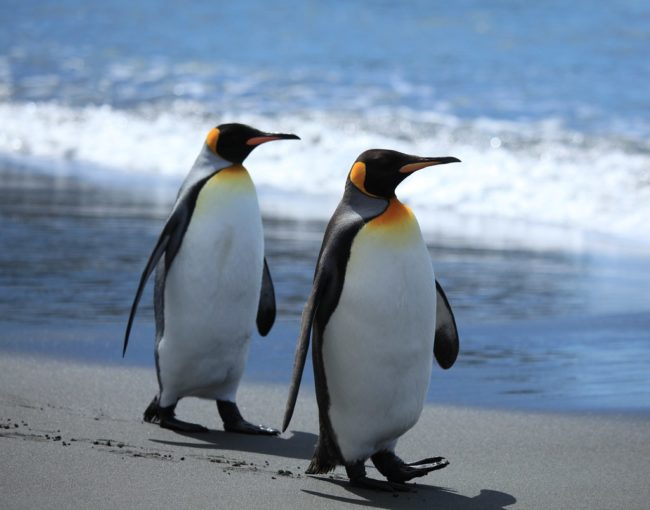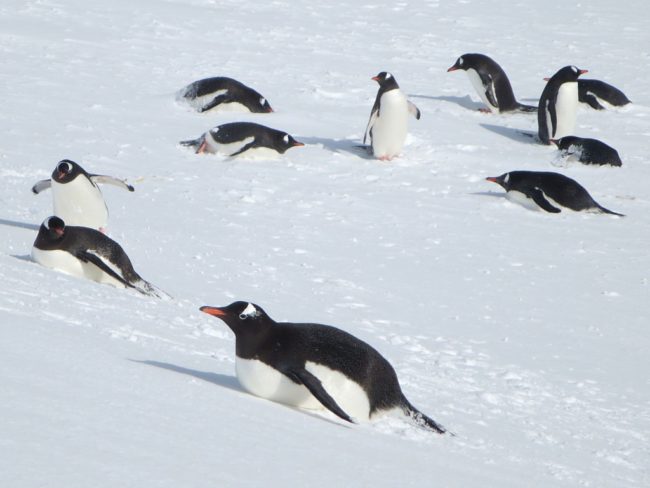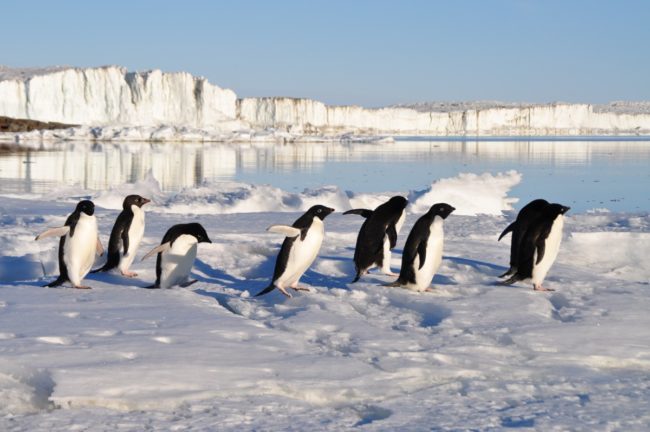Penguins are the representation of the Antarctic. They have a magnificent look and unique walking style. Penguins’ walk in their natural habitat is a delight to sight. Most of us think that penguins live only in the Antarctic, but these fantastic birds are spread across the Southern Hemisphere. Not all of them waddle in the icy Antarctic. More than 12 species of living penguins live in the temperate zones.
The waddle walk of penguins is the most heart-warming moment that the voyages/ trips to the Southern Hemisphere will gift the explorers. Many kids and wildlife crusaders have questions about penguins’ walk due to their upright bodies.
Many of us think that penguins cannot walk properly since their legs are made only to swim powerfully. Penguins waddle for many reasons that are helpful for them in reducing their stress in walking.
Though penguins waddle, they are efficient in walking on the icy land and swimming in the cold waters. Below are the various facts and details about the common question on penguins’ walking elegance.

Penguins in the Antarctic
Waddle walk:
Penguins waddle while walking to increase momentum and reduce energy consumption. They are the cutest while waddling; though the legs seem like a drawback, they gain most out of it.
Like other birds, penguins do not walk on their toes; instead, they walk on the soles of their feet. Even though penguins swim and glide effortlessly, walking takes twice the effort and energy. But the natural style of waddling reduces the strain and makes it comfortable to walk.
Waddling penguins at times fail while walking on the icy land or while climbing the small cliffs on the rocks, which is the most painful scene for a spectator. Scientists also say that penguins walk inconveniently due to their short legs and big feet.
Penguins’ waddle is more efficient than humans, says Timothy M.Griffin of the University of California at Berkeley back in 2000.
Penguins are graceful while swimming in the water and a delightful mess on land. Due to this, they pay for their flair on land by waddling, which is a gift. Scientists found that humans and other animals save 60 % of energy while walking and returning after a fail whereas, penguins save 80 % of their power by waddling.

Waddling penguins
Penguins have knees:
Anyone after watching penguins waddle will doubt whether these cute little creatures have knees or not. This question arises because of two reasons. One reason is that penguins’ legs are not visibly seen, and the other is that any living being that can walk has knees, but penguins waddle, which may seem like they don’t have knees.
The fact is penguins indeed have knees. Due to optical illusion, penguins’ legs look shorter than it is. Penguins’ feathers cover the upper legs and hide them, leaving us no suspicion. Penguins have the same bones as humans: femur, knee, tibia, and fibula.
Penguins’ legs are longer than they appear. The legs are set back of the body, which causes waddling that helps them increase the momentum and lessen the energy loss.
The evolution in penguin species resulted in spending more than half of their lives in water than on land. So penguins are good at swimming than walking on the ground.

Movement of penguins
Movements of penguins:
Penguins waddle, hop, and slide on the surface. Penguins waddle than walk because of their conventional body. The body’s upright position is due to the short head and neck with an elongated body with the legs set back.
Since penguins waddle side to side, they maintain the momentum to move effectively. Penguins hop or jump when required to carry on the rocky land or tampered drenches.
Penguins in frigid conditions usually glide on the icy surface to move faster, similar to people tobogganing in the ice during winters. Penguins slide with their bellies by propelling themselves forward with their flippers and feet in the snow to reduce energy consumption.

Penguins glide on the ice
How does penguin manage walking on ice?
We would have wondered how penguins could elegantly manage them whenever they walk on the ice. Penguins have webbed claws, which adds grip on the surface that they walk on.
Many of us even wonder about frostbites in penguins’ feet by seeing penguins walk on snow. Penguins’ feet are highly insulated to bear the freezing ice. This way may not be the only way they avoid getting cold.
Penguins’ internal mechanism also helps them in keeping warm. Penguins control the rate of blood flow to the feet. The temperature is maintained in the leg by holding it slightly above the freezing and preventing heat loss.
As we all know, some species of penguins like Galapagos live in temperate zones where they need to do the reverse mechanism that penguins do in severely cold climates.
Penguins’ feet play an essential role in heat exchange to thrive the extreme temperatures. Penguins that live in frigid climates walk on the snow with a knack. When Antarctic penguins rock side by side while walking, they lift their feet in each step and avoid prolonged contact with the ice.
Emperor penguins hunch and sit on their feet, covering them with dense feathers. The rocking side by the sidewalk is commonly noticed in penguins that live in the freezing Antarctic; those penguins include Chinstrap, Adelie, and Emperor penguins.
Giant penguins like Emperor and King penguins do not jump or hop; they waddle slowly due to their weight. Adelie penguins walk with a maximum speed of 3.9 kph. Smaller species like Rockhopper and Chinstrap penguins jump from one rock to another and run faster by hopping.

Adorable Adelie penguins
Penguins manage their fall efficiently:
Some penguin’s falls may seem brutal to our eyes, but those are still fun to watch as a penguin lover. Penguins are tricky, unlike humans. They get up and rise quickly after each fall which shows the adaptation to their environment.
After each failure of walking or climbing, the rock penguins make us feel like the most incredible animals. Usually, penguins manage to get up with the support of their strong beak on the ground, showing a flexible rise.
While witnessing a penguin lying down on its belly, the first question that arises in everyone’s mind is, how will he get up? Penguins lie on their bellies using their beak, flippers, and tail to push back to upright form, which is easier with their flexible neck.
When penguins fall over on the ice, they slide for a few steps and get up once the motion is stopped. The surprising thing is that the evolution in the species has made them adorable masters in walking on the ice.
Conclusion:
Penguins have a lot to tell humans about the trick of walking on ice. Following all penguins’ tips will surely benefit our clan, from walking upright, waddling, balancing the weight with the center of gravity on one leg, and much more. Extending the arms the sideways like penguins extend their flippers, humans can avoid a fall on the ice.
Most pregnant women waddle like a penguin after the first trimester, which is also due to the changes in the body structure after the added weight. Researchers found that pregnant women’s center of mass is beyond ordinary. Pregnant women curve backward and slightly bend their knees while walking as penguins do while waddling.
Watching a penguin waddle, jump, hop, run, fall, and slide will all make one happy. These graceful creatures leave us sitting with the pen between the teeth and a smile on our faces. They are adorable in anything they do, even a fall or gait.
Image Source:
Penguins in the Antarctic By Antarctica Bound / CC BY
Waddling penguins By Liam Quinn / CC BY
Movement of penguins By pingnews.com / Public domain
Penguins glide on the ice By David Stanley / CC BY
Adorable Adelie penguins / CC0 Public Domain
References:
-
https://www.scientificamerican.com/article/why-penguins-waddle/
-
https://www.penguinsinternational.org/2019/12/22/cold-feet-why-dont-penguins-feet-freeze/
-
https://www.parents.com/pregnancy/my-body/why-pregnant-women-waddle/
-
https://www.vox.com/2016/1/24/10822806/three-tips-to-walk-on-ice-do-it-like-a-penguin
-
https://seaworld.org/animals/all-about/penguins/physical-characteristics/